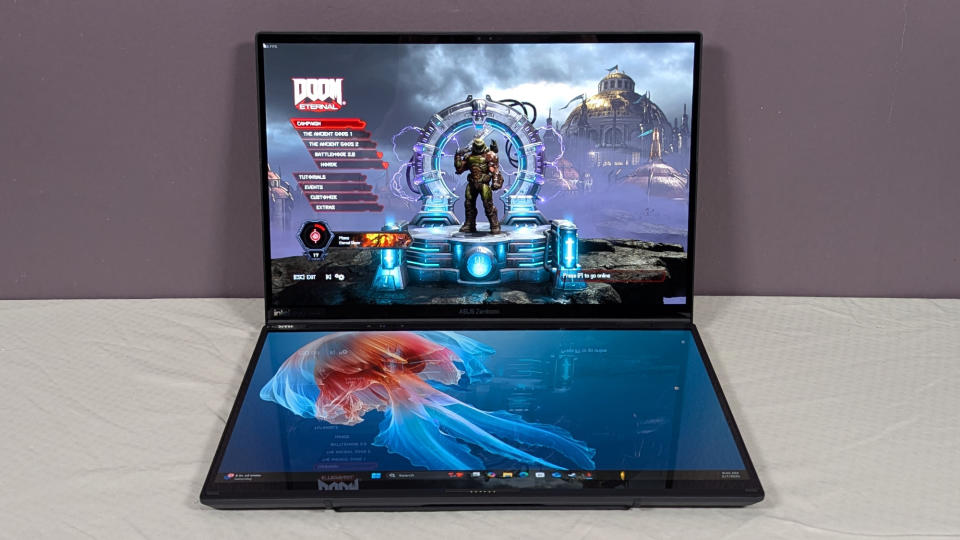When you buy through links on our articles, Future and its syndication partners may earn a commission.

Credit: Claire Tabari / Laptop Mag
Intel launched its new silicon this week, so naturally we wanted to see how it stacks up compared to the competition.
Intel’s Arrow Lake H systems launched yesterday, offering up to 20% increases in multithread performance over the previous Meteor Lake generation. Based on our testing of the Asus Zenbook Duo 2025 (UX8406) and MSI Prestige 16 AI Evo (B2HM), it seems Intel’s initial performance claims have held up in our testing.
Advertisement
Advertisement
But how does Arrow Lake H compare to the M4 and M4 Pro, or the Snapdragon X Elite (XIE-84-100)?
Let’s take a look at the numbers.
Arrow Lake-H Geekbench 6 performance

Intel Core Ultra 9 and Intel Arc Graphics badges on the MSI Prestige 16 AI Evo (B2HM) business laptop. | Credit: Future
In terms of gen-over-gen performance, the Intel Core Ultra 9 285H on the Zenbook Duo saw a 22% increase in Geekbench 6 multicore score over the Intel Core Ultra 9 185H on the Acer Swift Go 16. The Prestige 16 scored 32% higher than the Swift Go 16. All three systems had 32GB of RAM and a 1TB SSD. There are some build differences between the three laptops that can account for that variation, but this is about as close to a perfect comparison as we can get since our 2023 Prestige 16 and 2024 Zenbook Duo models featured an Intel Core Ultra 7 155H CPU.
What’s more exciting is seeing how Arrow Lake stacks up against the Apple M4 in the MacBook Pro 14, the M4 Pro in the MacBook Pro 16, AMD’s Ryzen AI 9 HX 370 in the Zenbook S16, and the Snapdragon X Elite (XIE-84-100) in the Samsung GalaxyBook 4 Edge.
Advertisement
Advertisement
Intel’s Core Ultra 9 285H processor is the high-end for Intel’s mid-range performance chipset, so we’ve pit it against the best of the best from the competition. On both the ZenBook Duo and the Prestige 16, Intel’s Arrow Lake outperforms the Apple M4, Snapdragon X Elite, and AMD Ryzen AI 9 on multicore performance. Apple still has the edge on Single-core performance, while Arrow Lake is more in line with Qualcomm and outperforms AMD on single-thread power.
The Prestige 16’s Core Ultra 9 Geekbench multicore scores were 15% higher than the Apple M4, but 31% behind the M4 Pro. This is about where we’d expect things to be, considering the M4 Pro outperforms the M3 Max for significantly less money.
Click to view chart data in table format
Arrow Lake-H HandBrake performance
Most folks don’t just sit around running Geekbench on their systems, so we supplement our performance testing with more real-world simulated benchmarks. Handbrake is a useful tool for measuring video editing prowess, which can get you a more holistic view of a laptop’s performance in stress tests.
Advertisement
Advertisement
More in Business
For our Handbrake test, we compress the 4K version of Tears of Steel into a more social media-friendly 1080p 30fps format and calculate the time it takes for the machine to complete the encoding.
The ZenBook Duo’s Intel Core Ultra 9 285H chipset took 5 minutes and 4 seconds to complete the compression, while the Prestige 16’s Core Ultra 9 285H was quite a bit faster at 4:12. This difference of nearly 1 minute between the two Core Ultra 9 laptops likely comes down to thermal management, since the Zenbook Duo is a dual-screen laptop while the Prestige 16 is a thicker, mid-range business device.
The ZenBook Duo’s Handbrake time is faster than the Zenbook S16’s Ryzen AI 9, while the Prestige 16 is faster than the M4 MacBook Pro 14 and Snapdragon X Elite Samsung GalaxyBook Edge 4. As expected, the M4 Pro smokes all of the other laptops on this list, but the Prestige 16’s 4:12 completion time is nothing to scoff at.
Click to view chart data in table format
Arrow Lake-H Gaming performance

Credit: Claire Tabari / Laptop Mag
We do have a more in-depth hands-on based around our experience gaming with Intel’s Arrow Lake-H systems, and the integrated Arc 140T deserves some serious praise, but what about the benchmarks?
Advertisement
Advertisement
None of the laptops on this list are gaming machines, but we do test them for gaming performance regardless as a way to evaluate the iGPU’s performance in 3D rendering, GPU-powered AI generation, and casual gaming settings.
Based on our cross-platform gaming benchmarks in Borderlands 3, Shadow of the Tomb Raider, and Sid Meier’s Civilization VI: Gathering Storm, the Arrow Lake-H gaming benchmarks on the Prestige 16 sit in close competition with the Apple M4 and AMD Ryzen AI 9. The ZenBook Duo’s gaming performance is a little slower than the MSI, but again that’s likely due to the thermal constraints of the Zenbook’s dual-screen chassis.
Interestingly, because Intel’s Arrow Lake is a successor to Meteor Lake, its iGPU isn’t quite as powerful as the Intel Arc 140V offered on Intel’s Lunar Lake chipsets. It isn’t a huge difference, but it does help explain why MSI opted for Lunar Lake on the Claw 8 AI+.
Click to view chart data in table format
Bottom Line
We have tested only two systems with Intel’s Arrow Lake-H silicon and both feature the Core Ultra 9 285H processor. So this is just a small look at what Arrow Lake-H is capable of via two premium spec laptops. Consider, however, that there are always performance variations thanks to implementation choices made by manufacturers. Some laptop designs will inherently thermal throttle more than others.
Advertisement
Advertisement
Despite that, things look pretty good for Arrow Lake H on the performance front, particularly when looking at industry standard benchmarks like Geekbench 6 and 3DMark.
While we can expect lower performance on multithread benchmarks from the Core Ultra 5 and Core Ultra 7 200H variants of the Arrow Lake H chipsets, it seems Intel’s early claims of up to 20% performance increase gen over gen adds up.
More from Laptop Mag
EMEA Tribune is not involved in this news article, it is taken from our partners and or from the News Agencies. Copyright and Credit go to the News Agencies, email news@emeatribune.com Follow our WhatsApp verified Channel





